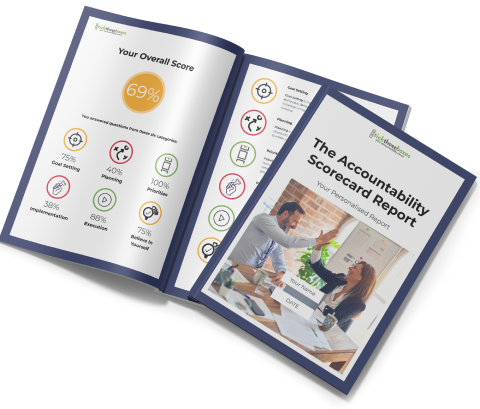
Posted on: 30/08/2023

The modern workplace is a dynamic ecosystem where individuals come together to collaborate, innovate, and achieve collective goals. Within this intricate web of interactions, the concepts of accountability and blame play a crucial role in shaping the culture and productivity of the organization. While these terms might appear similar, their implications are vastly different. Understanding the distinction between accountability and blame is essential for fostering a harmonious work environment and driving positive change that propels the organization forward.

Discover your Accountability Score and increase the probability of smashing your GOALS and Getting Sh!t Done!
Blame can poison the workplace environment like a slow-acting toxin. When blame becomes prevalent, it creates a toxic atmosphere of fear and mistrust. Team members hesitate to take risks, fearing repercussions if things don’t go as planned. This nature balming hinders innovation and creativity, as employees stay within their comfort zones. Let us imagine a scenario where a project fails to meet its deadline. A blame-driven response might involve singling out individuals to castigate for the failure. This behaviour not only demotivates the team members but also distracts them from the opportunity to learn from the experience and prevent similar issues in the future.
Before delving into the dynamics of accountability and blame in the workplace, it’s imperative to clarify their definitions. Accountability is taking responsibility for one’s actions, decisions, and outcomes. It involves a proactive approach to owning up to successes and failures, seeking solutions, and continuously striving for improvement. Blame, on the other hand, is the act of assigning fault or responsibility for a negative outcome without considering the bigger picture. The key distinction lies in their approach. Accountability focuses on growth, learning, and collaboration, whereas blame centres on finger-pointing, defensiveness, and stagnation. Blaming nature can hamper team dynamics, ethics and overall performance.
Accountability, in contrast, empowers individuals and teams. When held accountable, individuals take ownership of their actions and decisions. This ownership mentality fosters a sense of pride in one’s work and encourages proactive problem-solving. It also promotes a culture of transparency and open communication. Consider a situation where a sales team must catch up to its targets. An accountability-focused approach would involve a collaborative discussion about the challenges faced, potential strategies for improvement, and how the team can collectively work towards achieving their goals. This approach encourages shared responsibility and collective growth.
Creating a culture of accountability requires conscious effort and a commitment to positive change. Here are some strategies to foster accountability in the workplace:
Accountability doesn’t exist in isolation—it has a ripple effect that extends beyond individuals to teams and the entire organization. When groups collectively hold themselves accountable, it fosters a culture of mutual respect and support. The blame game is replaced by a mindset that seeks solutions, celebrates successes, and addresses challenges constructively. Moreover, accountability leads to continuous improvement. When individuals take ownership of their work, they are more likely to seek growth opportunities, pursue professional development, and contribute ideas that drive innovation.
Accountability and blame are threads that weave contrasting patterns in the intricate tapestry of the workplace. Blame creates a toxic environment, stifling growth and collaboration. On the other hand, accountability empowers individuals and teams to take ownership of their actions and decisions, fostering a culture of transparency, collaboration, and continuous improvement. For positive change to thrive in the workplace, it’s imperative to distinguish between accountability and blame. By embracing accountability, organizations can unlock the full potential of their teams, drive innovation, and navigate challenges with resilience. As we move forward in the ever-evolving landscape of work, let us remember that accountability is the compass that guides us towards a more productive, harmonious, and prosperous future. As we conclude this exploration, it’s evident that accountability and blame are not interchangeable concepts. Blame perpetuates negativity and hampers progress, while accountability lays the foundation for positive change. When individuals accept their roles in successes and setbacks, they create an environment where learning is valued, growth is embraced, and the collective pursuit of excellence thrives.
I was excited to join Tia Harmer on The Work in Progress: The Personal Productivity Science Insights Podcast! We dive deep into the science of goal setting and the power of accountability—two cornerstones of business and personal success.